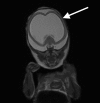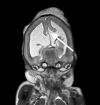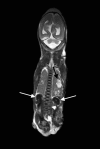Postmortem magnetic resonance imaging vs autopsy of second trimester fetuses terminated due to anomalies
- PMID: 30694559
- PMCID: PMC6618902
- DOI: 10.1111/aogs.13548
Postmortem magnetic resonance imaging vs autopsy of second trimester fetuses terminated due to anomalies
Abstract
Introduction: Our aim was to investigate the accuracy of postmortem fetal magnetic resonance imaging (MRI) compared with fetal autopsy in second trimester pregnancies terminated due to fetal anomalies. A secondary aim was to compare the MRI evaluations of two senior radiologists.
Material and methods: This was a prospective study including 34 fetuses from pregnancies terminated in the second trimester due to fetal anomalies. All women accepted a postmortem MRI and an autopsy of the fetus. Two senior radiologists performed independent evaluations of the MRI images. A senior pathologist performed the fetal autopsies. The degree of concordance between the MRI evaluations and the autopsy reports was estimated as well as the consensus between the radiologists.
Results: Thirty-four fetuses were evaluated. Sixteen cases were associated with the central nervous system (CNS), five were musculoskeletal, one cardiovascular, one was associated with the urinary tract, and 11 cases had miscellaneous anomalies such as chromosomal aberrations, infections and syndromes. In the 16 cases related to the CNS, both radiologists reported all or some, including the most clinically significant anomalies in 15 (94%; CI 70%-100%) cases. In the 18 non-CNS cases, both radiologists reported all or some, including the most clinically significant anomalies in six (33%; CI 5%-85%) cases. In 21 cases (62%; CI 44%-78%), both radiologists held opinions that were consistent with the autopsy reports. The degree of agreement between the radiologists was high, with a Cohen's Kappa of 0.87.
Conclusions: Postmortem fetal MRI can replace autopsy for second trimester fetuses with CNS anomalies. For non-CNS anomalies, the concordance is lower but postmortem MRI can still be of value when autopsy is not an option.
Keywords: fetal anomalies; fetal diagnosis; postmortem fetal MRI; prenatal diagnosis; prospective study; second trimester.
© 2019 The Authors. Acta Obstetricia et Gynecologica Scandinavica published by John Wiley & Sons Ltd on behalf of Nordic Federation of Societies of Obstetrics and Gynecology (NFOG).
Conflict of interest statement
None of the authors report any conflicts of interest.
Figures





Similar articles
-
Whole-body non-forensic fetal virtopsy using postmortem magnetic resonance imaging at 7 Tesla vs classical autopsy.Ultrasound Obstet Gynecol. 2024 Nov;64(5):661-668. doi: 10.1002/uog.29106. Epub 2024 Oct 7. Ultrasound Obstet Gynecol. 2024. PMID: 39376058 Free PMC article.
-
Correlation between prenatal ultrasound and fetal autopsy findings in fetal anomalies terminated in the second trimester.Prenat Diagn. 2007 May;27(5):457-62. doi: 10.1002/pd.1710. Prenat Diagn. 2007. PMID: 17335106
-
Accuracy and clinical utility of standard postmortem radiological imaging after early second trimester termination of pregnancy.Eur J Obstet Gynecol Reprod Biol. 2022 Jun;273:75-80. doi: 10.1016/j.ejogrb.2022.04.023. Epub 2022 Apr 27. Eur J Obstet Gynecol Reprod Biol. 2022. PMID: 35504117
-
Role of magnetic resonance imaging in fetuses with mild or moderate ventriculomegaly in the era of fetal neurosonography: systematic review and meta-analysis.Ultrasound Obstet Gynecol. 2019 Aug;54(2):164-171. doi: 10.1002/uog.20197. Epub 2019 Jul 11. Ultrasound Obstet Gynecol. 2019. PMID: 30549340
-
Fetal postmortem imaging: an overview of current techniques and future perspectives.Am J Obstet Gynecol. 2020 Oct;223(4):493-515. doi: 10.1016/j.ajog.2020.04.034. Epub 2020 May 4. Am J Obstet Gynecol. 2020. PMID: 32376319 Review.
Cited by
-
Visualisation of fetal meconium on post-mortem magnetic resonance imaging scans: a retrospective observational study.Acta Radiol Open. 2020 Nov 19;9(11):2058460120970541. doi: 10.1177/2058460120970541. eCollection 2020 Nov. Acta Radiol Open. 2020. PMID: 33282338 Free PMC article.
-
Are non-invasive or minimally invasive autopsy techniques for detecting cause of death in prenates, neonates and infants accurate? A systematic review of diagnostic test accuracy.BMJ Open. 2023 Jan 6;13(1):e064774. doi: 10.1136/bmjopen-2022-064774. BMJ Open. 2023. PMID: 36609326 Free PMC article.
-
Perinatal post-mortem magnetic resonance imaging (MRI) of the central nervous system (CNS): a pictorial review.Insights Imaging. 2021 Jul 22;12(1):104. doi: 10.1186/s13244-021-01051-0. Insights Imaging. 2021. PMID: 34292413 Free PMC article. Review.
References
-
- SBU . The Swedish Council on Technology assessment in Health Care. Routine ultrasound under pregnancy, report. Stockholm: ISBU, 1998.
-
- Amini H, Antonsson P, Papadogiannakis N, et al. Comparison of ultrasound and autopsy findings in pregnancies terminated due to fetal anomalies. Acta Obstet Gynecol Scand. 2006;85(10):1208‐1216. - PubMed
-
- Dickinson JE, Prime DK, Charles AK. The role of autopsy following pregnancy termination for fetal abnormality. Aust N Z J Obstet Gynaecol. 2007;47(6):445‐449. - PubMed
Publication types
MeSH terms
Grants and funding
LinkOut - more resources
Full Text Sources
Medical

